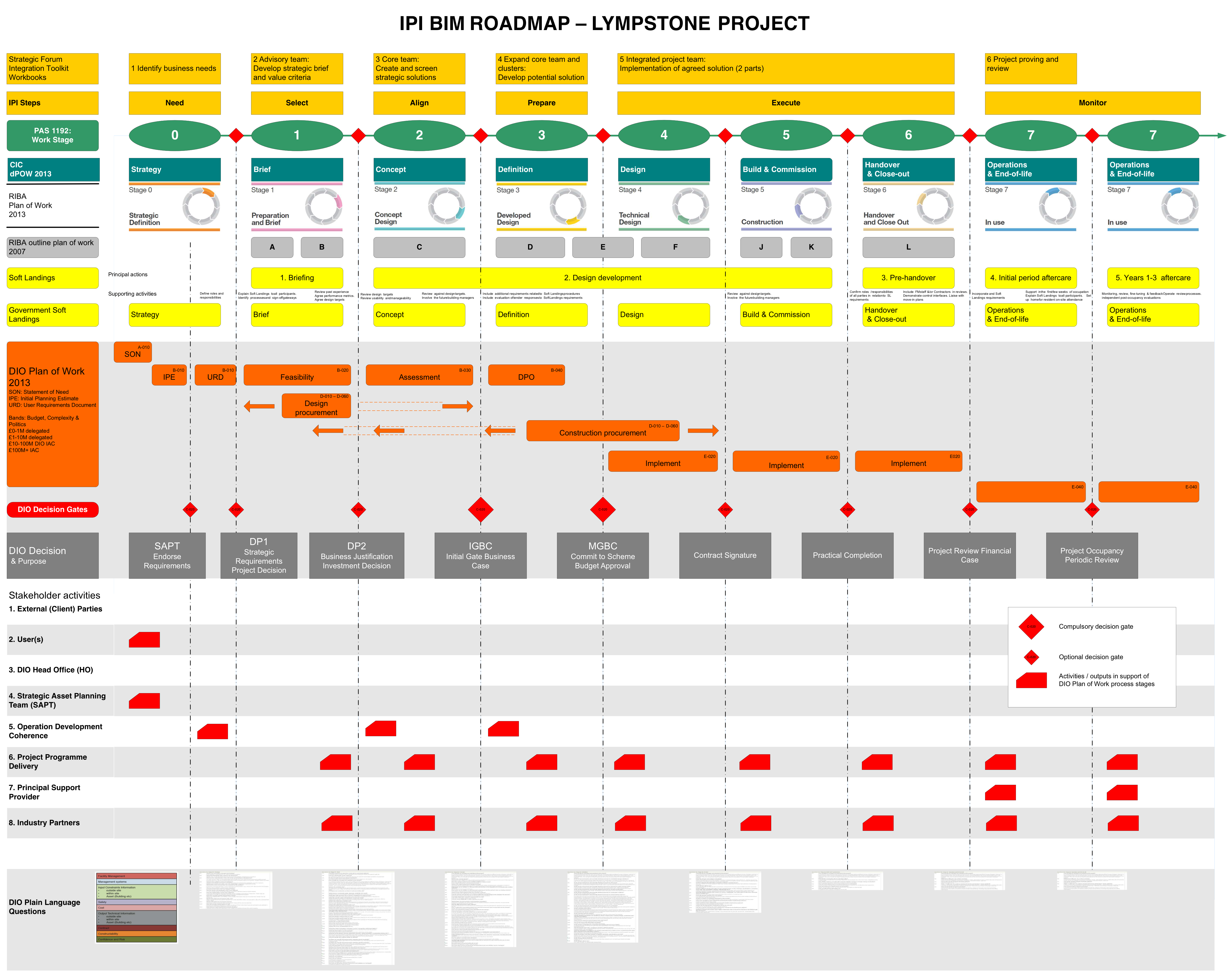Integrated project insurance BIM Roadmap
[edit] Project background (Source: Cabinet Office)
"The Government Construction Strategy (2011) set out to achieve savings in construction procurement of up to 20%. Reforming procurement practices to effect behavioural and cultural change underpins this effort. The Industrial Strategy for Construction (Construction 2025) re-emphasises Government’s continuing commitment to this effort. The context to this initiative has been set out in “New Models of Procurement – Introduction to the Guidance”.
Three new models of construction procurement (Cost Led Procurement; Integrated Project Insurance; Two Stage Open Book) have been trialled. Guidance for each describes the ‘how to’ in adopting the model to aid clients in the public sector, bringing together best practice and behaviours of leading practitioners to help generate savings being sought by Government. If clients and suppliers want to achieve the same level of outcomes demonstrated by the trial projects, then the steps and techniques set out in the guidance will help them to achieve this.
Through evolution rather than revolution, these models offer the potential to achieve efficiency gains that can be released for reinvestment, create new employment and industry activity, make projects more affordable and fundable, and make the UK construction industry more competitive."
[edit] About the the IPI Model and BIM Roadmap
The IPI (Integrated Project Insurance) Model was developed by Integrated Project Initiatives Ltd in conjunction with brokers Griffiths & Armour and promoted by the Specialist Engineering Alliance with the support of 30 practices and companies across the industry.
Monitoring of the initial projects was undertaken by a cross-industry consortium, including BSRIA, under a 4-year project “Rethinking the Build process – delivering more for less under the IPI model”, funded by the Technology Strategy Board.
As part of this work, BSRIA was engaged on various work packages dealing with the use of BIM on the trial projects. A key output from this effort was the IPI BIM Roadmap – a graphical representation of the activities and process necessary for BIM engagement on the trial projects. The Roadmap, shown here, follows the visual format used by the BIM Task Group in its work with Government departments, it can also be downloaded here.
The Roadmap takes the key integrated project working steps developed as a response to the Strategic Forum Integration Toolkit Workbooks, and maps them against established industry tools such as the RIBA Plan of Work 2013 (and the RIBA Outline Plan of Work 2007 for comparison) to help put them into context in a project environment. Other related initiatives such as Soft Landings, and GSL (Government Soft landings) have also been included.
Against this backdrop, there is space within the Roadmap for clients to set out their own procurement processes, identifying any important stages where key decisions need to be made. Stakeholders are also identified and included in the Roadmap, together with defining the questions which they need answers to in order to inform those decisions.
The various elements of the IPI BIM Roadmap reflect the processes and practices operated by the DIO (Defence Infrastructure Organisation) as sponsors of the initial trial project.
This article appears on the BSRIA news and blog site as "Integrated project insurance (IPI) BIM Roadmap" dated August 2014.
--BSRIA
[edit] Related articles on Designing Buildings
- Collaborative practices.
- Collateral warranties.
- Environmental Impairment Liability (EIL).
- Insurance.
- Integrated project team.
- Integrated supply team.
- Latent defects.
- Office of Government Commerce.
- Owner-controlled insurance.
- Professional indemnity insurance.
- Supply chain.
- Target cost contract.
- Two stage open book.
Featured articles and news
Homes England creates largest housing-led site in the North
Successful, 34 hectare land acquisition with the residential allocation now completed.
Scottish apprenticeship training proposals
General support although better accountability and transparency is sought.
The history of building regulations
A story of belated action in response to crisis.
Moisture, fire safety and emerging trends in living walls
How wet is your wall?
Current policy explained and newly published consultation by the UK and Welsh Governments.
British architecture 1919–39. Book review.
Conservation of listed prefabs in Moseley.
Energy industry calls for urgent reform.
Heritage staff wellbeing at work survey.
A five minute introduction.
50th Golden anniversary ECA Edmundson apprentice award
Showcasing the very best electrotechnical and engineering services for half a century.
Welsh government consults on HRBs and reg changes
Seeking feedback on a new regulatory regime and a broad range of issues.
CIOB Client Guide (2nd edition) March 2025
Free download covering statutory dutyholder roles under the Building Safety Act and much more.
Minister quizzed, as responsibility transfers to MHCLG and BSR publishes new building control guidance.
UK environmental regulations reform 2025
Amid wider new approaches to ensure regulators and regulation support growth.
BSRIA Statutory Compliance Inspection Checklist
BG80/2025 now significantly updated to include requirements related to important changes in legislation.
























